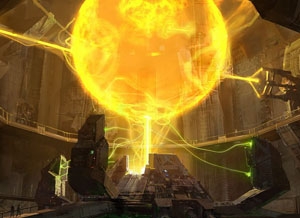
Putting the “Science” into “Science Fiction” – Fusion Power
The modern world runs on electricity and the demand for power continues to grow every year. As demand grows the non-renewable resources we rely on, mainly fossil fuels, are used at an accelerated rate while the production of renewable energy has not increased as quickly as people hoped. Scientists are working to discover new ways of meeting the growing energy demand without relying on fossil fuels and, as I have mentioned in past articles, much of this research is focused on creating power through nuclear fusion. Current nuclear fission power plants and the fusion plants that scientists hope to create both use nuclear forces to boil water to create steam, which turns turbines to generate electricity. The core difference, and the reason that nuclear fusion is so attractive, is the difference in how the heat is generated.
The nuclear fission reaction that is used in modern power plants works by firing a neutron into the nucleus of an atom of a fissile material. The impact causes the atom to undergo fission, breaking into smaller atoms and releasing additional neutrons and a great deal of heat. In a nuclear power plant the fissile material is arranged so that the neutrons from one fission reaction will strike other nearby atoms, creating a chain reaction that gives off enormous amounts of heat. The heat that is released by these reactions heats water to the boiling point and uses the resulting steam to turn turbines to produce electricity. Nuclear energy is very attractive because it gives off very little carbon dioxide, unlike fossil fuels, and produces ten million times more useable energy per unit of fuel than any other currently available power source. Although the advantages of nuclear power are clear they come with some major drawbacks as well.
The potentially catastrophic results of a nuclear power plant becoming damaged have been known since Chernobyl, and the  recent disaster in Japan has only highlighted the potential danger of even modern nuclear power plants. Another problem with power plants that use fission power is the amount of nuclear waste they create. This nuclear waste is highly radioactive, and will remain that way for thousands of years. This poses obvious problems for containing it. Although there has been talk of building many more nuclear fission power plants in the near future, concern over these issues have made them a much less desirable prospect. As the need for clean and renewable energy becomes greater other alternatives must be sought, and nuclear fusion offers a potential solution.
recent disaster in Japan has only highlighted the potential danger of even modern nuclear power plants. Another problem with power plants that use fission power is the amount of nuclear waste they create. This nuclear waste is highly radioactive, and will remain that way for thousands of years. This poses obvious problems for containing it. Although there has been talk of building many more nuclear fission power plants in the near future, concern over these issues have made them a much less desirable prospect. As the need for clean and renewable energy becomes greater other alternatives must be sought, and nuclear fusion offers a potential solution.
Although it has the same goal the way in which nuclear fusion works is the opposite of nuclear fission. In fusion a pair of atoms are smashed or crushed together, causing them to fuse into a single atom, releasing neutrons and even greater amounts of heat than nuclear fission. Like its counterpart fusion reactors would work by creating a chain reaction resulting in an increasing number of fusion reactions and more energy being produced. Unlike fission nuclear fusion is only possible with lighter elements, which are more plentiful and easier to find than the heavy elements that fission requires. The fuel that nuclear fusion power plants would likely use, though technically non-renewable, is estimated to be so common that supplies of it will far outlast the sun’s lifespan. Besides being plentiful this fuel will be much easier to extract that that used in nuclear fission plants, as it can be extracted from sea water without much difficulty as well as being found in other places. Although the plentitude of fuel is a large asset an even bigger benefit of fusion power is that it produces no radioactive waste. The waste from fusion reactions gives off no radiation and the radiation produced by the reaction itself ends immediately after the reaction ends, making it much safer than nuclear fission. The fusion reaction does not fully eliminate the problem of disposal of radioactive materials, as the components of the generator itself will become radioactive, but this radioactivity will fully dissipate within a few hundred years. While this is a long time it is a small percentage of the time that current fission waste remains dangerous, and only the core generators of fusion plants that have been shut down will need to be disposed of. The radiation given off by fusion cores will also be less intense than that of fission fuel rods, and constructing these reactors out of certain materials will also reduce the intensity and duration of radioactivity even further. When comparing nuclear fission to nuclear fusion there is no question that nuclear fusion is a superior power source in every way.
All the advantages of nuclear fusion begs the question of why it has not been adopted yet, and the main reason is that creating sustainable nuclear fusion reactions is very difficult. Although fusion reactions can be produced in laboratories they have not yet been perfected to the point where they produce more energy than it takes to initiate them. Once this hurdle is passed nuclear fusion is likely to become the main source of Earth’s energy very quickly. There are currently two main methods being examined to create sustainable fusion power; Inertial Confinement Fusion and Magnetic Confinement Fusion. Inertial Confinement Fusion involves heating a pellet of fusion fuel under intense pressure, usually through the use of lasers, with the hopes of having it reach a temperature where fusion begins. Although this approach seemed promising at first it was discovered to be less efficient than hoped, although recent improvements in laser technology have caused research into this area to increase in recent years. The other main avenue of fusion research, Magnetic Confinement Fusion, works using plasma’s natural electrical conductivity. By running an electrical current through a cloud of plasma a magnetic field is created around it, pressing the plasma inwards. As the plasma becomes more densely packed the magnetic field it produces becomes stronger, pushing it farther inwards and increasing the cycle. The hope is that the intense heat and pressure this technique generates will produce a fusion reaction. The main problems this method has encountered is difficulty in getting the charge into the plasma and issues with the plasma becoming unstable and losing temperature and pressure. The difficulties in creating and sustaining nuclear fusion also pose a potential safety benefit once fusion power becomes a possibility however, as without exactly the right conditions a fusion reaction immediately ends. This means that if a reactor was damaged of a malfunction occurred the reactor would immediately shut down, instead of suffering from a catastrophic meltdown like a fission plant would in a similar situation. This also means that fusions plants will be easier to miniaturize than fission plants, as they will not require as complex safety mechanisms.

Although fusion power plants are not yet feasible to build on a large scale, research is advancing rapidly and some estimates place the first commercial fusion plant as coming online in 2050. An experimental fusion power plant called the ITER is already undergoing construction and is estimated at completion in 2019. Once fusion reactors become feasible to build on a large scale it is likely they will rapidly overtake other methods of energy production, and advances in miniaturization may allow them to be built small enough to provide power for other applications such as spacecraft. The future of fusion power looks bright, and if it is allowed to live up to its promise it will usher in an age of cheap, safe, and clean energy for the entire planet.










